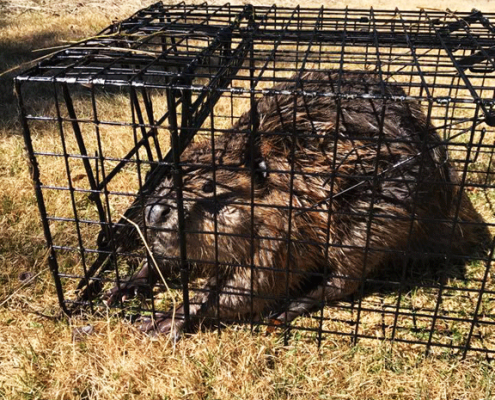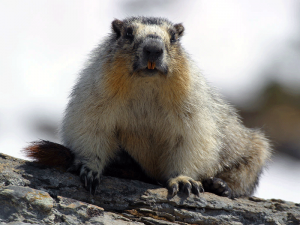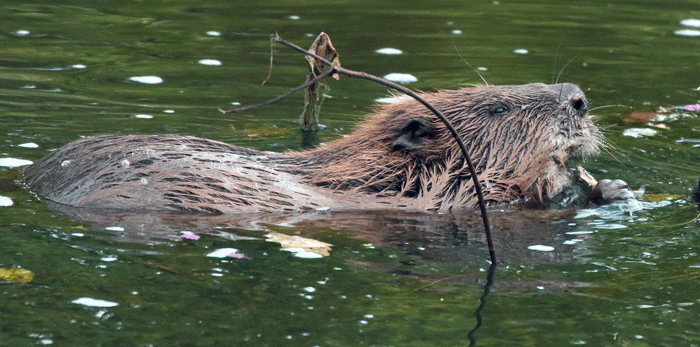
Beavers don’t get enough respect. After humans, they make the most impact on their environment, gnawing down trees with their vociferous teeth to construct vast water systems. From their dams and lodges to the network of canals, beavers are as ingenious as they are industrious. Our language is replete with idioms about being ‘busy as a beaver’ or being an ‘eager beaver’. But how much do we truly know about our buck-tooth buddy?
Over the past few centuries, we’ve whittled down their numbers to the edge of extinction. But beavers are bouncing back, with numbers rising across the northern hemisphere. So, let’s revisit our long-forgotten friend.
Beavers are nature’s builders – the grand architects of the north. Their impact on the ecosystem causes dozens, if not hundreds, of other species to survive. Thankfully, from near extinction, the beavers are back. Now you know what to look for!
Beaver solutions
Beaver Description
First things first – there are two types of beavers: Eurasian beavers (Castor fiber) and American beavers (Castor canadensis). Both battle it out to be the second biggest rodent – after the capybara, the South American giant – with the title going back and forth. The Eurasian beaver is generally considered larger, weighing in at around 35kg, compared with the American's 27kg. They're longer too. While the American beaver can grow to about 100 cm long, with an extra 30.5 cm for the tail, the Eurasian beaver manages 135cm. However, the Eurasian beavers' skull is smaller and their tail narrower.
Aside from their modest size, beavers are renowned for their large teeth. These incisors can grow up to 25 mm long, and continue to grow throughout a beaver’s life, needing to be continually worn down through chewing.
Though the teeth – colored red due to iron – certainly draw your attention, several other adaptations make the beaver perfectly suited to its waterside home. Closable nostrils and ears, as well as transparent eye membranes, allow the beaver to dive under the water, when swimming up into its den, or when traversing the wetlands they create. Plus, they're useful when giving a predator the slip.
Last, but certainly not least, is the beaver' tail. Scaled and black, the tail is entirely hairless, unlike their furry coat. American beavers have more prominent tails, used for swimming and balancing on land, for instance, when reaching up or climbing onto trees.
Beaver tracks are very distinctive if you can find them. The little critters have webbed hind feet that are large and broad and leave triangular prints, while their front feet are notable for their digits which are extremely hand-like. Though all feet have five digits, frequently you’ll see only four digits for the front feet, as the fifth doesn’t register on all surfaces. Front tracks will be around two to three inches in length, and claw marks may be present. There will be no arches, as beavers are flat-footed (plantigrade).
However, problems occur due to the beaver's flat tail which often drags behind, obscuring the prints as they go, especially in the snow. But the tail itself may leave drag marks, and partially covered tracks are a dead giveaway.
Other signs of a beaver include tree trunks with prominent teeth marks, and felled trees, with the characteristic chiseled-point – the calling card of a hungry beaver.
Alongside gnawed trees, you might notice beaver scat – like sawdust but cylindrical. It is the sign of an active beaver. Each scat will be around 1.5 – 2.5 inches long, with most being hard, as beavers re-ingest their soft droppings just like rabbits. These droppings will be found near water and will be dry, breaking up into a woody substance when disturbed.
Although not a dropping, beavers also excrete castoreum – a vanilla-flavored substance prized by perfume-makers – which is excreted from the castor sacs near their rear. Castoreum is used by the beavers to mark their territory. Look out for mounds of mud, grass, and sticks, which have been piled into a dome. These are scent mounds, upon which the beaver rubs the castoreum to alert other beavers of their presence. They can be a foot tall and three feet across.
Unsurprisingly, beavers aren't the most talkative bunch, preferring to labor in silence. Their young – known as kits – do make a noise like a duck quacking, but can also whine alongside other calls. On the other hand, adults stay almost entirely silent except for the odd grunt while at work. Sometimes barks and even crying can be heard, though the reason behind these noises is poorly understood.
The main exception is when in danger. Then a beaver might snarl at an approaching predator (or on occasion, another beaver), to warn them to stay away from their territory. Funnily enough, they don't even make their most characteristic noise. A tail slap is used to warn other beavers of danger. It is caused by the tail being brought down flat and firmly against the water, producing a distinctive slapping sound.
Beavers are exclusively herbivorous, preferring to chow down on a tasty bit of wood over the plethora of fish that swim in their waters. These curious critters enjoy willow and birch, maple and alder, cottonwood, quaking, aspen, and even a cherry tree. However, the beaver isn't interested in the hard, tasteless center; instead, they strip the nutritious bark from branches with expert precision. They also enjoy the ‘cambium’ – the soft and smooth layer hiding just below the bark.
As beavers do not hibernate, to prepare for the winter months beavers create stick stores by dragging branches down into their ponds and rooting them into the ground. During the chilly season, when the pond freezes over, the sticks are retrieved and consumed.
Through the summer months, woody plants comprise only ~10% of a beaver's diet, as most of their nutrition comes from aquatic plants. Rhizomes, pondweeds, bulrush, cattails, and water lilies are beaver delicacies, alongside ferns, leaves, and grasses.
However, beavers aren’t especially fussy, they’ll eat anything from clover to raspberry canes, as anyone who’s had them as neighbors will attest.
 Beavers are notoriously industrious, rivaling only humans in their ability to shape their habitat. As such, we often come into competition. While many beavers live alongside humans without issue, at times the sprawling expanse of the human-made world can butt heads with the beaver's own desire to expand.
Beavers are notoriously industrious, rivaling only humans in their ability to shape their habitat. As such, we often come into competition. While many beavers live alongside humans without issue, at times the sprawling expanse of the human-made world can butt heads with the beaver's own desire to expand.
Let’s walk through the main issues which can occur.
Tree Felling
Beavers are well-known for their tree felling antics, the characteristic chiseled stumps left behind in their wake. While for the most part taking down trees is not an issue, it can cause significant problems when the wrong tree in the wrong area is cut down. Beavers will make their way through a large tree with ease. These fallen trunks can block footpaths and roads and can damage overhead cables such as telephone lines as they fall. In theory, they could even injure a person standing in their way.
Trees are also economically important. A beaver in an orchard can cause hundreds if not thousands of dollars’ worth of damage in a few short days, becoming more than just a nuisance. Nor can a simple fence stop a beaver. These clever little critters will climb trees, steps, or ladders to get onto your property. They've even been known to squeeze through a tight opening to dine on the delicious plants beyond.
Back Flooding
All the tree felling isn't just for the sake of it; beavers drag these cumbersome trunks and limbs off into the water to build monumental dams. These dams are more potent than they look, for behind each dam acres of waterways and wetlands can arise. While this is valuable for wildlife, it can lead to the permanent flooding of croplands, gardens, homes, and any other valuable land adjacent to a river or stream.
Protective Measures
Though these events are annoying, they can be solved with some simple solutions.
Tree cages, made from hardened, galvanized steel, can protect against beavers gnawing at a tree. These sturdy, cylindrical barriers need to be tall enough to prevent the beaver from getting in. But thick enough that the beaver can't chew through – beaver's teeth can be as formidable as bolt-cutters, and they've been known to cut through fencing.
Alternatively, people often paint the tree with a paint and sand mix. As beavers dislike the gritty feel of sand in their mouth – and who doesn't – putting them off felling the tree. And if the beaver is still eager, electric fencing is also suitable for blocking off an entire area. If back flooding is the problem, farmers and other residents often take out a section of a dam or remove it entirely. The beavers will be annoyed, but they can live in burrows by the riverbanks.
Lastly, beavers can be captured and moved to areas where their natural tendencies to build can be put to good use. For instance, at the headwaters of a river, where studies have shown beaver dams slow the current, increasing water availability through the dry months, as well as reducing the risk of flooding during a torrent.
So, though they cause a lot of damage, we can learn to live together.
 Our hearts seem to melt when confronted with the small and furry. Beavers are no different. Their cute button nose, beady little eyes, and big buck teeth have made the beaver something of a pop-culture legend. We're more likely to think of beavers as industrious little critters, ‘beavering away’ – then to think of them as dangerous attackers.
Our hearts seem to melt when confronted with the small and furry. Beavers are no different. Their cute button nose, beady little eyes, and big buck teeth have made the beaver something of a pop-culture legend. We're more likely to think of beavers as industrious little critters, ‘beavering away’ – then to think of them as dangerous attackers.
However, the bright ember orange incisors of a beaver can devour through a tree trunk, let alone the soft squishy flesh of an animal or person. So, beavers can pack a punch. Therefore, with beaver numbers increasing year on year across both Europe and North America, it’s important to ask: are beavers dangerous? And should we take precautions?
Beavers and Humans
Beavers are not known for their aggression. After all, their dams are built to avoid predators' interactions by flooding the surrounding landscape. Nevertheless, no matter how cute or cuddly they might appear, beavers are wild animals. If trapped or provoked, they will attack, and they can be quite territorial. With chisel-like incisors up to 20 to 25 mm long, a beaver bite will hurt like a nail through your hand. So, keep your distance.
However, there have been reported cases of beavers being even more aggressive. Even deadly.
In 2013, a 60-year-old man in Belarus approached a beaver to take a photo. When the man got close, the beaver leaped on him, biting his thigh. The teeth hit an artery, and the man bled to death before medical assistance arrived.
In 2018, a Pennsylvanian man was kayaking when a beaver attempted to board his craft. After smacking the beaver several times, the critter did not budge. Instead, attacking the man's young daughter, at which point the man was able to beat the beaver away.
Though these stories are infrequent, they do emphasize the importance of caution with wild animals, especially with creatures such as beavers, which can be infected with rabies.
Warning Signs
When riled, nervous, or provoked, beavers will give off warning signals before initiating conflict. A snarl is a characteristic behavior, often seen in males, occurring when a beaver suspects danger is approaching their waters. If a beaver feels their territory has been invaded, they will slap their big flat tails on the surface of the water.
Keep your eyes peeled for these behaviors when dealing with beavers.
Beavers and Animals
Beavers are herbivores, meaning they only eat plants. Therefore, their aggressive behaviors are not predatorial but purely territorial. It's hardly surprising that creatures who build such elaborate homes are overly protective of them. Be careful about letting dogs get too close. The beaver will think nothing of biting their nose. Sometimes they'll even fight amongst themselves.
Though we should give beavers their space, we're far more dangerous to them than they are to us. Beaver numbers dived in recent centuries due to fur hunting and have only just started to recover. So, don't be scared of our buck-tooth buddy, just be a little careful.
